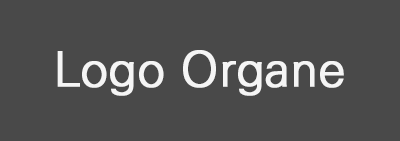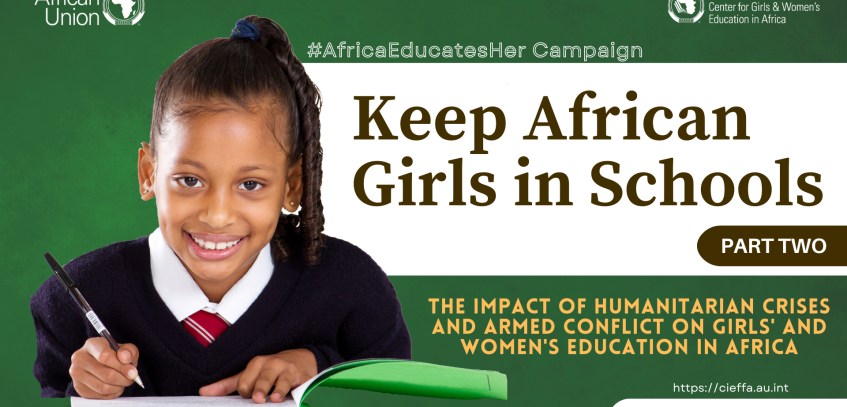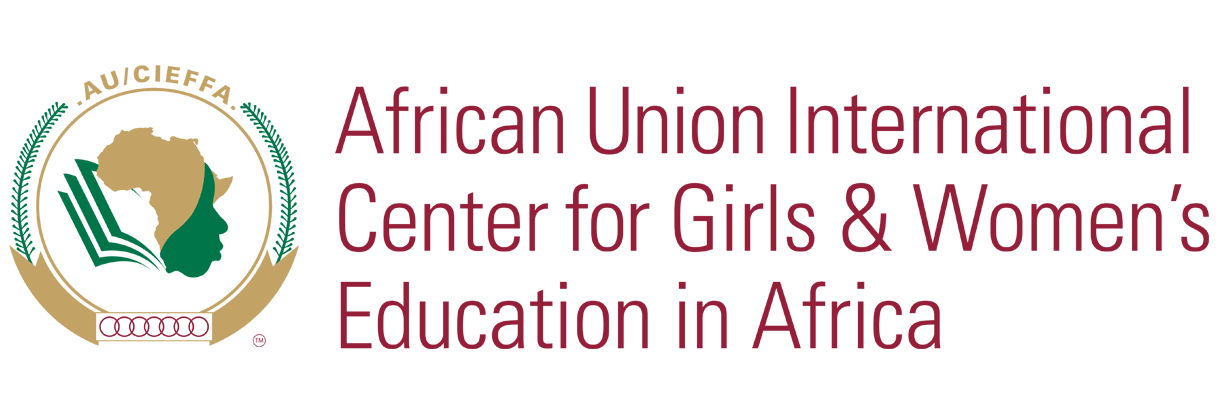Lorato Palesa Modongo & Hachim Boubakari
Keep African Girls in Schools; A 4 Part Series
African Union CIEFFA launched the #AfricaEducatesHer campaign in September 2020 as a rallying call for AU Member States to adopt affirmative actions and policies to encourage girls to return to school particularly after COVID19 pandemic and to remain in school beyond the pandemic.
In 2023, African Union CIEFFA through the #AfricaEducatesHer campaign engaged stakeholders working on the intersections of education, gender equality, and humanitarian contexts to explore existing opportunities, challenges and imagined solutions for girls and women’s education in Africa even beyond the Campaign. Past and emerging challenges affecting girls’ and women’s education were identified and categorized into 4 main categories: Socio-Cultural, Economic & Health, Psychological, Political & Environmental thematic areas.
In this 4 Part series of ‘Keep Girls in Schools’, each thematic area will be discussed.
Africa is facing a series of complex multi-layered political challenges including humanitarian crises, ethnic, political, religious, or territorial tensions, and climate shocks terrorism, and decades of armed conflict. The repercussions of this instability and insecurity are varied often leading to displacements, loss of lives, destruction of infrastructure, social disruption, public health crises, collective and individual physical, and psychological trauma.
In ters of displacements, according to United Nations Refugee Agency, more than half of all refugees in Africa are children. This has a devastating impact on their access to learning, quality of learning, and completion rates particularly for girls and women. According to UNESCO estimates, sub-Saharan Africa is home to almost 30% of the world's out-of-school children, with 1 in 5 African children not being in school (19.7%). Further evidence suggests that only half of all children in schools reach upper secondary school. One of the main reasons for this lack of access to schools, and low completion rates is political instabilities, conflict, and humanitarian crises.
Political instability in Africa hinders the establishment and maintenance of functional education systems, consequently affecting girls' access to education. It is imperative to analyze the various impacts of these crises on girls' and women's education in Africa through the effects of humanitarian crises, the consequences of terrorism, and the repercussions of armed conflict. It is even more imperative to identify solutions to mitigate these effects, consequences, and impacts.
Schools as socializing institutions, often offer beyond reading and writing for children. They are an integral part of their socialization, integration into society and facilitate learning motor, sensory, social, and emotional skills. For children leaving in poverty, schools can offer safe haven where they may access other critical psycho-social and child protection service such as access to nutrition through school feeding programs, healthcare, and psychosocial support through play, and from teachers.
In instances of armed conflict and war where schools become unsafe, and infrastructure get destroyed children are forced to abandon school. This therefore takes away the added benefits of schools beyond the learning aspect. Below, we explore effects of these crises on girls and women’s education.
The Effects of Humanitarian Crises on Girls' and Women's Education
Forced displacements resulting from these crises contributes to increased instability and insecurity, limiting girls' access to quality education and exposing them to risks of violence, sexual exploitation, early and forced marriages, early pregnancies,
The Consequences of Terrorism on the Education of Girls and Women
Terrorism poses a direct threat to the safety of schools and educational establishments, creating a climate of fear and insecurity that deters girls from attending school. Terrorist attacks often target girls and women and children, putting them at increased risk of sexual violence, forced recruitment and psychological trauma. These threats hinder girls' access to education and compromise their general well-being. To mitigate these consequences, it is essential to strengthen school security, raise community awareness of the risks associated with terrorism, and provide psychosocial support to girls and women affected by terrorist violence.
The Impact of Armed Conflict on the Education of Girls and Women
Armed conflict has a devastating impact on girls' and women's education in Africa. Schools are often the target of deliberate attacks, resulting in the destruction of educational infrastructure and the disruption of curricula. Furthermore, forced displacement resulting from armed conflict exposes girls to increased risks of violence, recruitment by armed groups and early marriage, hampering their right to a safe and equitable education. Armed conflict severely disrupts girls' education by destroying schools, forcing their closure and forcing families to flee their homes, thus interrupting girls' schooling and exposing them to risks of violence, exploitation and early marriage and pregnancy further plunging them into poverty.
To mitigate the impact of humanitarian crises, terrorism and armed conflict on girls' and women's education in Africa, holistic and coordinated solutions are needed. Here are some possible measures:
- Investment in educational infrastructure: Rebuild and rehabilitate educational infrastructures damaged by armed conflict and humanitarian disasters, ensuring that they are resilient and accessible to all, especially girls and women.
- Non-formal education programs: Set up flexible non-formal education programs tailored to the needs of girls and women affected by crises, providing distance learning, evening classes and remedial programs for those who have been forced to drop out of school.
- Humanitarian response coordination: Improve coordination between humanitarian actors, local governments and civil society organizations to ensure a holistic and effective response to the educational needs of girls and women in crisis situations.
- Maintain education in times of crisis: Advocacy and call to action for governments and donors to invest in maintaining education in times of crisis, by allocating adequate resources, funding and integrating education into humanitarian and development action plans.
- Capacity building for educational institutions: Build the capacity of local educational institutions to respond to the needs of girls and women in crisis situations, integrating gender-responsive approaches and fostering a culture of equality and inclusion.
- Investing in women's economic empowerment: Promote women's economic empowerment by providing education and vocational training opportunities, facilitating access to financial services and supporting the development of small businesses run by women.
- Community awareness and mobilization: Raise community awareness of the benefits of education for girls and women, emphasizing the positive impacts on health, economic development and social stability, and mobilize their support to ensure equitable access to education for all.
- Protection against gender-based violence: Strengthen laws and policies to protect girls and women from gender-based violence, by putting in place effective reporting and response mechanisms and providing support to survivors of violence.
- Teacher training: Train teachers to recognize and respond to the specific needs of girls and women in crisis contexts, with an emphasis on raising awareness of gender issues, gender-based violence and the inclusion of girls in education.
- School safety: Strengthen school security by working with local security forces and implementing appropriate security measures to protect students and teachers from terrorist attacks and conflict-related violence.
References
African Union. 2022. The African Union Accountability Framework on the Elimination of harmful practices.https://au.int/sites/default/files/newsevents/workingdocuments/41106-wd-AU_ACCOUNTABILITY_FRAMEWORK_ON_THE_ELIMINATION_OF_HARMFUL_PRACTICES-_ENGLISH.pdf
Equal Measures. 2021. Leveraging partnership data: Strengthening girls' education in emergencies with ODF. https://equalmeasures2030.org/wp-content/uploads/2022/03/GAC-policy-rep…
FAWE. (2024). Burkina Faso Country Report: "Improving knowledge of gender norms and understanding resistance to change to promote gender equality in education". https://fawe.org/national-chapters-and-regions/burkina-faso/
Institute for Security Studies. 2017. Making African Schools Safe for pupils and teachers. https://issafrica.org/iss-today/making-africas-schools-safe-for-pupils-and-teachers
W Michelle Kabore/Zougba. (2021). "Impact de la crise sécuritaire actuelle sur les filles, le genre et l'éducation" https://reliefweb.int/report/burkina-faso/impact-de-la-crise-securitaire-actuelle-sur-les-filles-le-genre-et-leducation.
UNHCR. (2018). United Nations High Commissioner for Refugees. Global Trends: Forced Displacement in 2017.








